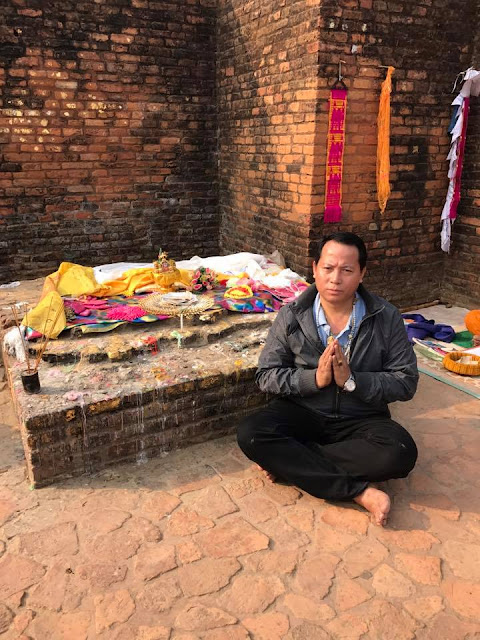(The throne of Buddha from where he performed miracles)
I am very fortunate to visit the exact location
where lord Buddha displayed several miracles at Shravasti.
Initially, I thought it had happened within the
enclosure of Shravasti. But No, the exact place is around 2 km away from
Shravasti. Located on a hillock of around 50 meters height, it prominently stands
tall in the middle of vast plain all around. Any number of people can be easily
be accommodated, and I have concluded the very reasons why Buddha had chosen
the ideal location with millions of people gathered during that event to witness
the challenges.
(The ruined monastery, inside is the throne of Buddha from where
he performed miracles)
We can still see the throne that Lord Buddha
used. I am totally touched by the monumental evidence and had visualized Buddha
sitting there.
The miracle of the "double appearances.
When the Buddha laid down a rule forbidding the exercise of supernatural powers
by monks - following on the miracle performed by Pindola Bhāradvāja - the
heretics went about saying that henceforth they would perform no miracles
except with the Buddha.
King Bimbisāra reported this to the Buddha, who
at once accepted the challenge, explaining that the rule was for his disciples
and did not apply to himself.
(The hillock in the middle of vast plain where Buddha throne was
located)
He, therefore, went to Sāvatthi, the place
where all Buddhas perform the Miracle. In reply to Pasenadi, the Buddha said he
would perform the miracle at the foot of the Gandamba tree (mango tree) on the
full moon day of Asālha.
This was in the seventh year after the
Enlightenment.
The leaders of India's six main philosophical
schools had challenged the Buddha to a contest of miraculous powers many times
as he wandered through the surrounding kingdoms.
Six evils, heretic teachers led by Purnakasyapa
had become mad with resentment and jealousy against the Buddha, and tried to
engage him in a contest of miraculous powers, which Mara had persuaded them
they could win. King Bimbisara laughed them out of court when they petitioned
him, but they persisted, and finally he went to request the Buddha's
participation.
The Buddha agreed, but stipulated that he would
set the time of the contest. A teaching throne was set up in a large arena at
Rajagrha, but shortly before the proposed contest, the Buddha and all his
followers departed for Vaisali. Seeing this as an admission of defeat, the six
heretic teachers were elated, and rushed after the Buddha, with their ninety
thousand followers, and after them, king Bimbisara and his entourage. The
heretics urged the Licchavi king to stage the contest there, and the Buddha
again accepted, but said he would set the time.
(The ruined structure)
The Buddha then moved on, from one city to the
next; each time giving the same answer, and gathering a new following, until
they came to Shravasti.
The heretics soon arrived, and remonstrate with
king Prasenajit not to allow any further postponement, and the Buddha assented
that the time had now come. Buddha was fifty-seven years old when the
conditions were most auspicious to accept this challenge.
King Prasenajit built a hall in Shravasti
especially for the event; in it seven thrones were erected. On the new moon of
the first month of spring (what is now known as losar, the beginning of the
Bhutanese new year), the six other teachers took their seats and Shakyamuni
came to his flying through the air.
He was honored with extensive offerings. He
then sent forth fire and water from his body and the hall was destroyed and
reformed as a transparent palace.
Before the kings of all the capitals he had
passed through, the six heretics and their followers, and a huge assembly of
gods and humans, he performed inconceivable miracles for the next fifteen days.
- On the first day, he created a bounteous tree by planting his toothpick in the ground, causing a great tree to spring up, fragrant and fully laden with flowers and ripe fruit.
- On the second day, he manifested two jeweled mountains.
- On the third day, he produced a jewel lake.
- On the fourth, voices came from the lake explaining all aspects of the Dharma.
- On the fifth day, golden light spread from his countenance and filled the world, purifying the emotional poisons of sentient beings.
- On the sixth day, he allowed people to read each other’s thoughts.
- On the seventh, he transformed his benefactors into world-rulers.
- On the eighth day, the Buddha pressed down on the throne with the fingers of his right hand, and with a thunderous roar, the fierce Vajrapani appeared from beneath, brandishing a flaming vajra at the heretic teachers. Four beings in Vajrapani's retinue scattered the heretics and smashed their thrones.
(Enjoying great moment at the feet of Buddha’s throne)
The heretics were so scared that they leapt
into the river. Then, the Buddha radiated eighty four thousand rays of light,
one from each pore of his skin, which filled the sky. On the tip of each ray
was a lotus, and on each lotus a buddha, with attendants, teaching Dharma, and
all were amazed, and some were liberated by the sight of it.
In these eight days Buddha Shakyamuni utterly
defeated his opponents. The ninety thousand followers of the six heretic
teachers adopted the Buddhist doctrines, joined the monkhood, and later became
arhats. For a further seven days Buddha Shakyamuni continued to show miracles
and give teachings to the great assembly.
At the conclusion of the Miracle, the Buddha,
following the example of his predecessors, made his way, in three strides, to
Tāvatimsa, there to preach the Abhidhamma Pitaka to his mother, now born as a
devaputta.
Indeed a Great Discovery during the enriching
Naykhor.








